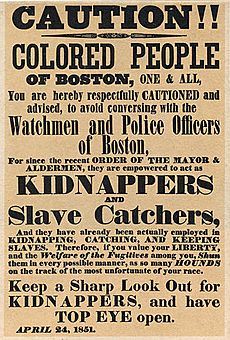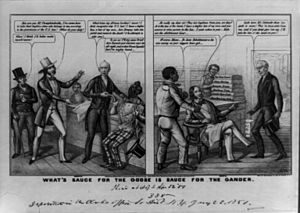Fugitive Slave Act of 1850 facts for kids
 |
|
| Long title | An Act to amend, and supplementary to, the Act entitled "An Act respecting Fugitives from Justice, and Persons escaping from the Service of their Masters", approved February twelfth, one thousand seven hundred and ninety-three. |
|---|---|
| Enacted by | the 31st United States Congress |
| Citations | |
| Public law | Pub.L. 31-60 |
| Statutes at Large | 9 Stat. 462 |
| Legislative history | |
|
|
| Major amendments | |
| Repealed by Act of June 28, 1864, 13 Stat. 200 | |
The Fugitive Slave Act was a law passed by the United States Congress on September 18, 1850. It was part of a larger agreement called the Compromise of 1850. This law was created to help slave owners in the Southern United States get back people who had escaped slavery and fled to the Northern states.
The Act was very controversial. It made many people in the North worried about the power of slave owners. The law said that all escaped enslaved people, once caught, had to be returned to their owners. It also forced officials and regular citizens in free states to help catch and return them. People who were against slavery nicknamed it the "Bloodhound Bill." This was because dogs were often used to track down people escaping slavery.
This law made the country even more divided over the issue of slavery. It was one of the main reasons that led to the American Civil War.
Contents
Why Was This Law Needed?
By the 1840s, many enslaved people successfully escaped to the North each year. This made slavery less stable, especially in states near the border between North and South.
An earlier law, the Fugitive Slave Act of 1793, already existed. It was meant to make sure that escaped enslaved people were returned, as stated in the U.S. Constitution. However, many Northern states did not want to follow this older law.
Northern States Resisted
Some Northern states passed their own "personal liberty laws." These laws often required a jury trial before someone accused of being an escaped slave could be moved. Other laws stopped local jails or state officials from helping to arrest or return these people. Sometimes, juries in the North refused to find people guilty who had helped those escaping slavery.
In 1842, the U.S. Supreme Court ruled in a case called Prigg v. Pennsylvania. The court said that states did not have to help catch or return enslaved people. This decision made the 1793 law much weaker.
Raids and Southern Demands
After 1840, many Black families, both free and escaped, moved to Cass County, Michigan. They found a safe place there, partly because many Quakers in the area supported them. This good fortune caught the attention of Southern slave owners.
In 1847 and 1849, slave owners from Kentucky led raids into Cass County to try and recapture people. These raids failed, but they made Southern politicians demand a stronger fugitive slave law in 1850. Southern politicians often made the number of escaped enslaved people seem larger than it was. They blamed abolitionists in the North for encouraging escapes and interfering with their property rights.
The New Law of 1850
Because the old law was not working well, Senator James Murray Mason of Virginia wrote the Fugitive Slave Act of 1850. This new law made it very difficult for enslaved people to gain freedom.
Strict Rules and Penalties
The 1850 law punished officials who did not arrest someone accused of escaping slavery. They could be fined $1,000. Law enforcement officers everywhere had to arrest people suspected of escaping slavery based only on a slave owner's sworn statement.
A person accused of being an escaped slave was not allowed to have a jury trial. They also could not speak in their own defense. The official who heard the case was paid $10 if they decided the person was an escaped slave, but only $5 if they decided the proof was not enough. This payment system encouraged officials to rule against the accused.
Also, anyone who helped an escaped person by giving them food or shelter could be jailed for six months and fined $1,000. Officers who caught an escaped person could get a bonus or a promotion.
Impact on Free Black People
Slave owners only needed to provide a sworn statement to a federal officer to capture someone. Since suspected enslaved people had no rights in court, this law led to free Black people being kidnapped and forced into slavery. They could not defend themselves against false accusations.
The Act made it much harder for enslaved people to escape, especially in states close to the North. Studies show that the price of enslaved people in border states went up by 15% to 30% after 1850. This shows how the law made successful escapes less likely.
Northern Resistance to the Law
Many people in the North strongly opposed the Fugitive Slave Act. It forced them and their communities to help enforce slavery, which went against their beliefs. This law made many moderate people in the North become stronger opponents of slavery. It also inspired Harriet Beecher Stowe to write her famous book, Uncle Tom's Cabin (1852).
Many abolitionists openly broke the law. For example, Reverend Luther Lee of Syracuse, New York, said in 1855 that he would never obey it. He claimed to have helped 30 enslaved people escape to Canada in one month.
There were several times when Northern communities acted against the law. In Syracuse, abolitionists used force to free an escaped slave named Jerry. They then helped him escape to Canada. Other famous examples include Shadrach Minkins in 1851 and Lucy Bagby in 1861. Their forced return showed how harsh the law was.
Judges and Juries Resisted
In 1855, the Wisconsin Supreme Court was the only state court to say the Fugitive Slave Act was against the Constitution. This happened in a case involving an escaped slave named Joshua Glover. However, the U.S. Supreme Court later overturned this decision in 1859.
Northern juries sometimes refused to find people guilty who were accused of breaking the law. This was called "jury nullification." Daniel Webster, a strong supporter of the law, wanted to see people convicted. But the juries' actions ruined his hopes of becoming president.
States Passed New Laws
In November 1850, the Vermont legislature passed the Habeas Corpus Law. This law required Vermont officials to help captured escaped slaves. It also created a state court process for people accused of being escaped slaves. This made the federal Fugitive Slave Act almost impossible to enforce in Vermont.
This was seen as "nullification" of federal law, which was a concept popular in the South for different reasons. President Millard Fillmore even threatened to use the army to enforce the Act in Vermont. Other states like Michigan, Connecticut, Massachusetts, and Ohio also passed their own "personal liberty laws" to protect people from the Fugitive Slave Act.
Escape to Canada
One major result of the Fugitive Slave Act was that Canada became the main goal for people escaping slavery. Before, many tried to reach free states in the North. The Black population in Canada grew from 40,000 to 60,000 between 1850 and 1860. Many reached freedom through the Underground Railroad.
By 1855, about 3,500 Black people in Canada were those who had escaped American slavery. In Pittsburgh, after the law passed, groups of escaped people, armed and ready to fight, left for Canada. More than 200 men left in one month. The Black population in New York City also dropped by almost 2,000 from 1850 to 1855.
However, many Northern business owners supported the law. They had strong business ties with the Southern states. They formed groups to promote the law, especially in New York City. This caused some public opinion to shift towards supporting the law.
The End of the Act
At the start of the American Civil War, the Union (Northern states) did not have a clear plan for people escaping slavery. Many enslaved people fled to Union army lines. At first, Union soldiers often returned them to their owners.
However, some Union generals, like Benjamin Butler, refused to return them. He took enslaved people as "contraband" (enemy property) and set them free. He argued that taking away their labor would hurt the Confederacy. President Abraham Lincoln allowed Butler to continue this.
In August 1861, the U.S. Congress passed the Confiscation Acts. This law stopped slave owners from re-enslaving captured people. It made military emancipation (freeing enslaved people by the army) an official Union policy. But it only applied to enslaved people used by rebel owners to help the Confederate cause.
Union Army forces sometimes still returned escaped people until March 1862. Then, Congress passed a law stopping Union forces from returning anyone to slavery. The Fugitive Slave Act was finally and officially ended in June 1864. The New York Tribune newspaper celebrated this, saying the "blood-red stain" was "wiped out forever."
Images for kids
-
Print by E. W. Clay, an artist who published many proslavery cartoons, supports the Fugitive Slave Act of 1850. In the cartoon, a Southerner mocks a Northerner who claims his goods, several bolts of fabric, have been stolen. "They are fugitives from you, are they?" asks the slaver. Adopting the rhetoric of abolitionists, he continues, "As to the law of the land, I have a higher law of my own, and possession is nine points in the law."
See also
 In Spanish: Ley de esclavos fugitivos de 1850 para niños
In Spanish: Ley de esclavos fugitivos de 1850 para niños




